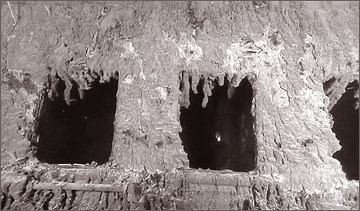Twenty fifth anniversary of Titanic discovery
Brian Handwerk
The images of Titanic in late August are among the first results of
the ongoing Expedition Titanic. Its goals: to use acoustic imaging,
sonar, and 3-D video to virtually preserve Titanic in its current state
and to help determine just how far gone the shipwreck is and how long it
might last.
Due to recent hurricane activity, the expedition crew is currently
docked in St. John’s, Newfoundland, some 560 kilometers from Titanic’s
North Atlantic resting place—but the team is eager to get back to work.
“What we have witnessed, so far, has been nothing but extraordinary,”
Chris Davino, CEO of Premier Exhibitions, Inc., said in a press
statement.
|

Rust “icicles” plague the 2.4-mile-deep shipwreck Photograph
courtesy Premier Exhibitions, Inc. and Woods Hole Oceanographic
Institution |
“We are anxious to return to the site and continue this
groundbreaking expedition,” added Davino, whose company’s RMS Titanic,
Inc., division organized the expedition with Woods Hole Oceanographic
Institution.
Well deck, ill preserved
A National Geographic Society-funded team led by ocean explorer
Robert Ballard rediscovered the shipwreck in 1985.
Pictures taken since then show a wreck beset by metal-eating
life-forms, powerful currents, and possibly even human negligence,
suggesting Titanic could be vanishing for good, scientists say.
Already explorers have documented caved-in roofs, weakening decks, a
stern perhaps on the edge of collapse, and the disappearance of
Titanic’s crow’s nest—from which lookout Frederick Fleet spotted
history’s most infamous iceberg.
Rusticles form as microbes eat away at Titanic and form
self-contained, icicle-like biological communities.
By 1996 there were some 650 tons of rusticles on the outside of
Titanic’s bow section alone, according to estimates by microbiologist
Roy Cullimore, a microbiologist and veteran Titanic explorer. Since then
rusticles have continued to grow both inside and outside the wreck.
Window on Titanic decay
“Everyone has their own opinion” as to how long Titanic will remain
more or less intact, research specialist Bill Lange, of Woods Hole
Oceanographic Institution said.
“Some people think the bow will collapse in a year or two,” Lange
said.
“But others say it’s going to be there for hundreds of years.” So far
the expedition’s pictures show that the two major sections of Titanic’s
hull—the ship split in two before sinking—are whole.
Expedition Titanic’s data should help experts predict how long the
wreck will remain relatively stable. “We’re trying to bring the actual
hard data to the people who can make those determinations,” Lange said.
Strolling into oblivion
Built in Belfast, U.K., the 270-meter-long luxury liner was the
world’s largest passenger ship when it launched in 1912. On its maiden
voyage, Titanic hit an iceberg and sank, killing more than 1,500 people.
To Robert Ballard, who found Titanic 25 years ago Wednesday, the
shipwreck site should remain undisturbed as a “sacred grave.” Instead,
salvagers, tourists, and filmmakers have “turned her into a freak show
at the county fair,” he’s said.
Titanic unbound
The next leg of Expedition Titanic will retrieve hard evidence of
corrosion—steel test platforms that look something like
mini-stepladders. First deployed in 1998, the platforms have endured the
same destructive conditions as Titanic itself. Because the scientists
know precisely how thick the platforms were at deployment, they allow
researchers to gauge exactly how fast metal degrades at the Titanic
site. “Basically we look and see how much steel is left on them,”
Cullimore, the microbiologist, said. The estimated rate of decay should
allow scientists to better predict just how long Titanic will remain
fairly intact.
Titanic mast, unmoored
Rusticles may infest the interior of the mast, which might completely
collapse in the next year or two, speculated Cullimore, founder of
Regina, Canada-based Droycon Bioconcepts, Inc., a biotechnology company.
Already the foremast is a symbol of Titanic’s inevitable decline.
On an early 1990s dive, P.H. Nargeolet, co-leader of Expedition
Titanic, saw that the crow’s nest—previously seen still attached to the
forward mast—had disappeared altogether, apparently damaged to the point
where it snapped off and fell to an as yet unidentified location.
- National Geographic |



